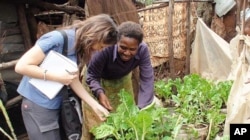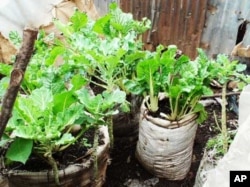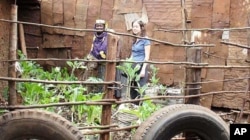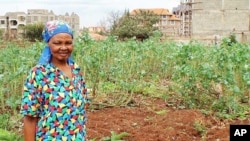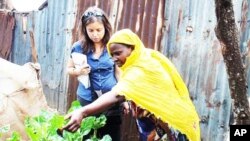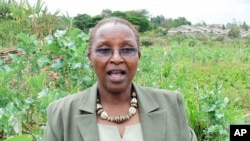This is Part 2 of a 5-part series: Innovations in African Farming
Continue to Part: 1 / 2 / 3 /4 /5
On just 10 hectares of land in the center of Nairobi, almost a million people wage a daily battle to survive. Kibera slum in Kenya’s capital city is infamous for terrible poverty, brutal crime and filthy living conditions, often leading to disease and death.
But there’s also an aspect of life in Kibera that, among all the suffering and tragedy, remains hidden. Here, said leading international agricultural researcher Danielle Nierenberg, 1,000 residents have “transformed” themselves into farmers.
“With the food they grow in between their shacks and even alongside gutters, they’re saving many thousands of people from being hungry every day,” she said.
Nierenberg works for the Worldwatch Institute, a sustainable development NGO based in Washington, D.C. She recently visited the urban farmers of Kibera. She named two “remarkable” Kenyan agricultural researchers, Professor Nancy Karanja and Mary Njenga of Nairobi’s Urban Harvest NGO, as the “power” behind the project.
Nierenberg said the two women have taught Kibera residents an “amazing innovation” known as “vertical farming.” Karanja and Njenga were themselves trained by the Consultative Group on International Agricultural Research.
‘Lifeline’ of urban agriculture
Njenga commented, “In vertical farming, people really don’t need any land. They grow food directly outside their houses. Kibera is densely packed, so there is not much land available, so this is the only way the people can farm here.”
Vertical farms are made using recycled or biodegradable sacks, filled with soil and livestock manure. Crops such as kale, spinach and onions are planted, and holes are poked in the sacks for drainage. The sacks can also be stacked one above another, using shelving, saving space and increasing productivity.
Nierenberg said the concept of vertical farming is “simple but highly effective” in producing food in extremely limited spaces.
Njenga said the farmers of Kibera also grow food on nearby “unused plots, under the power lines, along the river banks, along the roadsides.”
She described urban agriculture as a “lifeline” for the people of the area, most who live on less than one dollar a day. “Food has become very expensive in African cities like Nairobi. It’s such a big challenge [for residents] to put food on their table. So, when they are able to produce their own food instead of buying, it quite literally saves lives. Firstly, they use their produce to feed themselves, and secondly, if there is surplus, they sell it to generate income,” Njenga told VOA.
Nierenberg described the Kibera growers as an “example to the world in the way they are growing food in the middle of a slum land.”
The Worldwatch Institute estimates that food purchases absorb up to 80 percent of a typical urban family’s income, so even a small amount of food grown at home alleviates financial stress. Njenga’s and Karanja’s research has shown that people in poor households practicing urban agriculture eat more meals and have more balanced diets than those who don’t.
Njenga said the political violence that swept Kenya after the 2008 elections provided a “graphic example” of the growing importance of urban agriculture. The turmoil resulted in transportation being disrupted and food supplies into Nairobi from the rural areas were cut off.
Nairobi’s urban farmers, especially those in Kibera, said Njenga, “stepped into this gap” and supplied many people in the city with food. “The people in Nairobi…did not go hungry because a lot of vegetables were coming from the urban and [peripheral] urban areas,” she stated.
Land insecurity
But Kibera’s urban farmers face some serious challenges, including the fact that they don’t own any land and could thus be evicted at any time – cutting them off from their vital food production activities.
“Many times they just look for any open space [on which to plant crops] – some of it belonging to government, some of it belonging to institutions. Therefore they have no land tenure security and this affects the kind of investments that they put into the agriculture,” said Njenga.
She gave the example of a company that had given some Kibera residents permission to cultivate crops on its unused land. But, said Njenga, this arrangement was only temporary, and the firm had recently instructed the farmers to leave the land so that it could build on it.
“So those farmers lost heavily, they could no longer produce food and have to start all over again at different places that are not so productive,” she said. If the shack dwellers of Kibera owned property, she maintained, they’d “definitely” be growing more food. “They don’t grow a lot,” Nienga said, “because they are afraid of losing all their crops at any given time.”
Water dilemma for Kibera farmers
Kibera is so underdeveloped that it doesn’t have a formal water supply, so farmers here struggle to water their crops. “Lots of them are actually forced to buy water that is meant for drinking, in 20 liter jerry cans. That is another big expense for them,” Njenga explained. “Others collect water from rivers nearby. That’s a lot of work.”
She said some of the growers use “untreated” wastewater to irrigate and fertilize their plants. “They use it direct from the sewerage pipeline,” she added.
Njenga said this “tapping into” Nairobi’s sewage system often brings the farmers of Kibera into conflict with the city authorities. The city council orders the food producers not to use wastewater because of dangers associated with coming into contact with untreated sewage.
“We happen to have done a study where the main risk was found to be heavy metals, because the water comes from both houses and industrial sources. So as well the water containing human waste, it also contains heavy metals,” said the researcher.
The authorities say the farmers, through contact with the sewage, could absorb poisonous heavy metals such as mercury, aluminum and lead that factories have discarded, through their skin, leading to various potentially fatal diseases.
But the farmers are willing to take these risks, arguing that the wastewater is a constant source of free irrigation and is also a rich source of fertilizer.
Using wastewater also allowed the Kibera farmers to embark on another “special” project, said Njenga. With constant access to irrigation through the sewage system, they were able to harvest a lot of seeds. Some of the seeds were sold to other urban farmers but most were sold to farmers in Kenya’s rural areas.
“Usually it’s the rural farmers who supply seeds to the city farmers but here we had city farmers benefiting rural agriculture. This is just another example of how valuable urban farming is becoming,” said Njenga.
Governments not doing enough
So far though, said Nierenberg, African governments have largely “ignored” and “neglected” urban agriculture. But Karanja said there are “some indicators” to suggest that the continent’s political leaders are willing to support urban farmers.
She explained that the Kenyan government, for example, has developed a draft policy [on urban farming] and the Cabinet was considering it. Karanja insisted that in Africa it is local municipalities and urban planners who are resistant to urban agriculture, “not so much” national governments.
“In Africa, these local authorities have not come to visualize the concept of urban farming. At the moment, most just don’t see the value of it, and how it can be used to combat poverty. They just see urban farmers as a nuisance, as people who are using land and other resources illegally,” she said.
The Worldwatch Institute has appealed to governments across the world to give “greater political recognition” to urban agricultural practices, so that city farming can become more sustainable and more productive. “Urban agriculture should be included in urban development and land use plans and be regulated by municipalities,” it said.
Also hindering urban food production in Africa at the moment, said Karanja, was “poor cooperation” between the various role players. “There’s [a lack of communication] between the urban policymakers, the urban planners and the people involved in food production and environmental managers.”
Despite this, Karanja remained convinced that political authorities throughout Africa have “good will” regarding urban agriculture. But she added that “there’s a way [to go] to change the thinking among the many stakeholders. It takes time to convince everybody [to support urban farming]. In politics in Africa it takes a long time to put everything straight.”
But Njenga adds “it would be best” if the political powers act “very soon” to develop urban agriculture. An estimated 15 million people are moving to urban areas in Africa every year, and experts estimate that by 2020, about 40 million Africans will depend entirely on food grown in cities.




